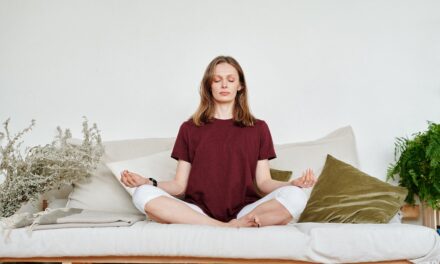One of the most common symptoms of anxiety is difficulty sleeping. To be able to fall asleep easily and enter deep sleep, the body must switch from the sympathetic nervous system, which controls fight, flight, and freeze, to the parasympathetic nervous system, which controls rest and relaxation. When a person’s nervous system is in a long-term state of fear (which is common with people experiencing anxiety), it can be hard to activate the parasympathetic nervous system long enough for deep sleep to occur.
The American Sleep Association states that between 50 and 70 million American adults have some kind of sleep disorder. The most common is insomnia, which is the inability to fall or stay asleep. About 30% of adults report occasional insomnia, and about 10% report chronic insomnia. Insomnia that lasts for a few nights or a few weeks is considered short-term, while insomnia that persists for months or even years is considered chronic.
Sleep hygiene is critical to stress tolerance and general mental health. Given how common sleep issues are, it can be helpful to use body-relaxing techniques to help you fall asleep faster and deeper. Sleep tapping is a common method used to help make the transition into deep sleep.
What to expect from our article
Sleep tapping – emotional freedom technique
Emotional Freedom Technique (EFT) is an alternative way to treat both physical pain and emotional distress. It can also be called “tapping” or “psychological acupressure.” EFT tapping is still being studied, but it has been used successfully to help people with anxiety and post-traumatic stress disorder (PTSD). EFT can also be used to improve sleep quality. Tapping helps reduce cortisol levels. High cortisol increases stress, and stress can cause sleep problems.
There are five steps to EFT tapping. If you have more than one problem or fear, you can repeat this sequence to lessen or eliminate negative thoughts and feelings.
1. Identify the issue
For this method to work, you must first figure out what is bothering you or what you are afraid of. This will be the centre of your attention. You will get better results while you tap if you only work on one issue at a time.
2. Evaluate the intensity of the issue
Once you figure out where the problem is, you need to give it a level of intensity. The intensity level is rated on a scale from 0 to 10, with 10 being the most severe. The scale measures how much your identified issue hurts you emotionally or physically.
3. Establishing a phrase
Before you start tapping, you need to establish a phrase that describes the issue you want to change. A common phrase to use is, “Even though I have this [fear or problem], I deeply and completely love and accept myself.”
4. EFT tapping order
When using the EFT tapping technique, you tap on the meridian points in a particular order. There are 15 main meridian pathways on each side of the body that lead to an internal organ. They are easy to remember because tapping points start at the top and move down the body.
- SS: The Sore Spot – Neurolymphatic Point
- EB: Beginning of the Eyebrow – Bladder Meridian
- SE: Side of the Eye – Gall Bladder Meridian
- UE: Under the Eye – Stomach Meridian
- UN: Under the Nose – Governing Vessel
- Ch: Chin – Central Vessel
- CB: Beginning of the Collar Bone – Kidney Meridian
- BN: Below Nipple – Liver Meridian
- UA: Under the Arm – Spleen Meridian
- TH: Top of the Head – Governing Vessel
- Th: Thumb- Lung Meridian
- IF: Index Finger – Large Intestine Meridian
- MF: Middle Finger – Heart Protector
- BF: Baby Finger – Heart Meridian
- KC: Karate Chop – Small Intestine Meridian
Use any two fingers along either side of the body to perform the tapping sequence. It is not necessary to tap on both sides, but switching from one side to the other is perfectly acceptable. Start by tapping your “karate chop point” or massaging your “sore spot,” and say the phrase three times.
Beginning at the eyebrow point and tapping each point approximately seven times each, tap the points in the body in the order they appear. Finish the cycle at the top of the head after the underarm point.
5. Determine the intensity.
After two rounds of tapping, use a scale from 0 to 10 to rate how bad the problem is. Repeat the tapping technique until you feel relief. If the problem hasn’t gone away or has only gotten slightly better, you should tap in sequence again.
Our top 10 essential sleep hygiene habits
If you are having trouble sleeping, there are simple things you can do to improve your sleep. Good sleep habits are referred to as “sleep hygiene.” Creating a relaxing daily routine can not only help calm the mind, but it can also help you fall asleep quicker and stay asleep longer. Good sleep hygiene is important for your mental and physical health, as well as the quality of your sleep and your overall quality of life.
- Avoid drinking caffeine or alcohol; these can act as stimulants, which will stop you falling asleep and can even prevent deep sleep.
- Avoid watching TV, using your phone, or doing anything else that will stimulate your mind or body before going to bed.
- Try to go to bed and wake up around the same time each day, as this can train your body to sleep better. Where possible, try to avoid taking naps, as this can interfere with night time sleeping.
- Create a space that is conducive to sleep. Dark, quiet, and cool environments generally make it easier to fall asleep and stay asleep.
- Take a bath. Evidence shows that taking a bath or a shower before bed can help reduce your core temperature, allowing you to fall asleep quicker.
- Introducing a daily exercise routine can improve sleep quality. Yoga or gentle stretches are great before bed as they can help you relax, but you should try to avoid vigorous exercise later in the day or before bed.
- Meditate or listen to calming music. Both of these can help calm your mind and prepare you for sleep.
- Keep a sleep journal. Writing things down can help you clear your mind of anything that may be worrying you.
- If you are lying awake and can’t fall asleep, get up and do something relaxing for a little while. Tossing and turning can cause more frustration, which could be stopping you from falling asleep.
- Avoid napping during the day, as it can make it harder to fall asleep. Napping during the day can also cause you to wake up in the middle of the night. If you do need to take a nap, limit it to 30 minutes or less, and try not to nap in the late afternoon.
Breathing exercises
Take a few deep, relaxing breaths as soon as you get into bed. Breathe in through your nose, filling your chest, throat, and abdomen with air. Hold the inhalation for a few seconds, then slowly let it out through your mouth. You should feel like a balloon that is slowly deflating. Take several of these long, deep breaths, allowing your body to sink into the bed a little more with each exhalation. Repeat until you become calm and relaxed.
For more helpful tips, see our how to fall asleep fast with anxiety article.












